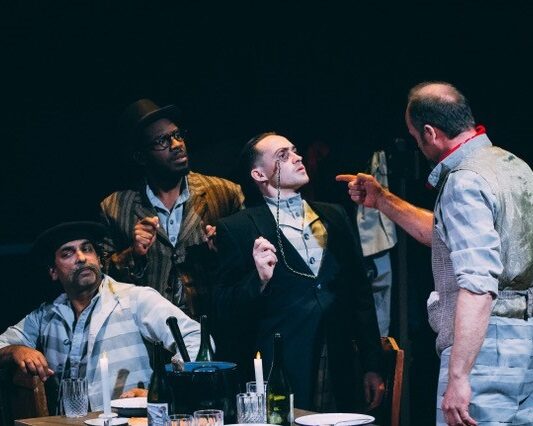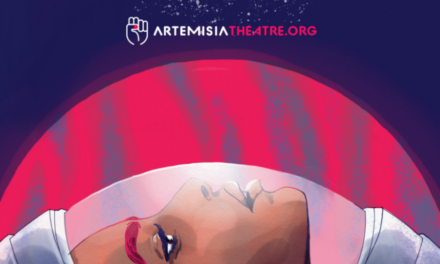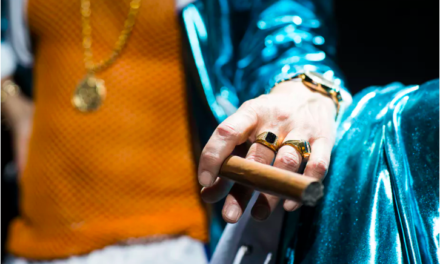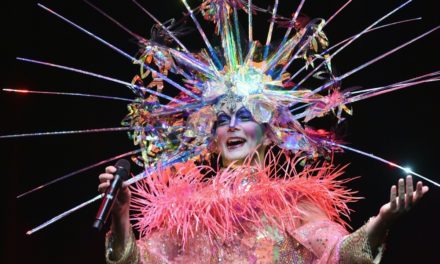Multi-layered, profound yet fluid and highly engaging.
When a scene involving melons and murder plays out, I get a strong sense of déjà vu…Turns out it’s an actual memory of a scene from Indian Ink’s The Dentist’s Chair which premiered a decade ago.
Commissioned by the prestigious South Coast Repertory Theatre, based in Orange County, Southern California,* Welcome To The Murder House brings a backstory-cum-subplot from that impressive but flawed (in my opinion) production to take the stage in its own right in this world premiere at Te Auaha’s Tapere Nui (Big Theatre), Wellington, New Zealand.
In The Dentist’s Chair, a depressed and reclusive dentist, Albert Southwick, is haunted by the ghost of Alfred Southwick (no relation), the dentist from Buffalo, New York State, who conceived of the electric chair in 1881 and saw his invention executed, so to speak, in 1890.
In Welcome To The Murder House, Alfred’s story is told, in the popular vaudeville style of the day, by a group of prison inmates. For them, Southwick is a hero, given their shared belief that execution by electrocution will be more humane than hanging. And, as with the development of all high-quality theatre, it takes a lot of trial and error to get it right.
In his program note, co-writer/lyricist and actor Jacob Rajan says a playwright’s job is “to ensure that your story goes deep but travels light” and this play–created with co-writer/lyricist and director Justin Lewis and dramaturg/lyricist Murray Edmond–certainly achieves that. The dynamics of vaudeville keep it lively while drawing our attention to what lurks in its darker recesses.
Wonderfully judicious liberties are taken, not so much to alter the key facts as to integrate other historical elements in order to dramatically interrogate the universal themes that elevate this story from the prosaic:
- the individual’s vs the state’s right to kill a person;
- a woman’s rights over her own body vs a man’s sense of entitlement to it;
- “truth” proven through rigorous science vs irrational faith driven by emotion.
So the ever-practical Alfred Southwick, strongly earthed by Matthew Chamberlain, is counterpointed by “sex radical” Mary Flynn, brought to highly-charged life by Jacquie Drew. In claiming the right to enjoy the pleasures of sex for its own sake, she takes the initiative, relying on the efficacy of a Goodyear rubber sheath, and as an eager participant in their love life, he has to accept she has no desire for children.
While Alfred believes if a man does wrong he has to take what’s coming to him, Mary believes in prison reform and the abolition of the death penalty. It’s when he witnesses a tortuous hanging (and thank goodness we see the harness device as well as the noose, given how vividly the scene is played out) that Alfred sees the potential of this new-fangled thing called electricity to bring relief from pain and suffering in the throes of death.
Much is made of the difference between direct and alternating currents (DC vs AC). In an ingeniously-conceived sequence, Indian scientist Jagadish Chandra Bose (a classic Jacob Rajan characterization) survives the indignities of trying to gain entry to the exclusive Union Club, only to have his electronic crescograph plant movement detector demonstration sabotaged by a self-serving Harold Brown (one of many characters superbly played by Patrick Carroll) and his dog: a wonderful creation by Tim Denton, brought to life by Drew).
Quentin Warren (recently arrived from LA) plays the death row inmate who narrates where necessary and becomes the condemned William Kemmler, ever-grateful to Alfred for wanting to ease his path to oblivion. The aforementioned scene where Willy reacts lethally to the free-spirited antics of fresh produce-hawker Tilly (Drew) is vividly enacted. Even though Willy believes he “did the right thing,” he is willing to accept the consequences and Warren ensures we empathize with his desire for a quick and painless death.
The history of execution techniques is entertainingly sketched. The process by which Alfred gains the support of the Establishment generates a clever duck-shooting scene involving balloon-sculpted birds. A court scene name-checks George Westinghouse and manifests Thomas Edison. The climactic scene is harrowing and demands we each confront our values.
Between them the five actors delineate some 30 roles with great alacrity, facilitated by excellent Elizabeth Whiting–designed costumes, building on basic striped prison attire. John Verryt’s set and props designs enrich the action, as does Jane Hakaraia’s lighting design.
Given the four male inmates are designated as a horse thief, moonshiner, forger, and murderer, they cannot all be on death row (as suggested in an early media release). While their base-characters remain unexplored, with the audience at least, the actors have doubtless used those ideas as foundations for the roles they play.
The music, sometimes redolent of O Brother Where Art Thou, composed by David Ward and played live on stage– along with ingenious sound effects–by Ward, Eamon Edmundson-Wells, and Sean Quentin-Buss, is integral to the show and adds enormous value. And the singing is sublime: solos from Jacque Drew and Quentin Warren especially, and also the ensemble singing which includes the musicians’ voices.
Multi-layered, profound yet fluid and highly engaging, Welcome To The Murder House is a worthy addition to the impressive Indian Ink lexicon.
– – – – – – – – – – – – –
*South Coast Repertory Theatre presented a reading last October, with US actors. Plans for a US production have yet to be finalized.
WELCOME TO THE MURDER HOUSE!
Written by Jacob Rajan & Justin Lewis
Directed by Justin Lewis
Presented by Indian Ink Theatre Company
at Te Auaha – Tapere Nui (Big Theatre), 65 Dixon Street, Te Aro, Wellington
Until June 10, 2018
This post was written by the author in their personal capacity.The opinions expressed in this article are the author’s own and do not reflect the view of The Theatre Times, their staff or collaborators.
This post was written by John Smythe.
The views expressed here belong to the author and do not necessarily reflect our views and opinions.


















